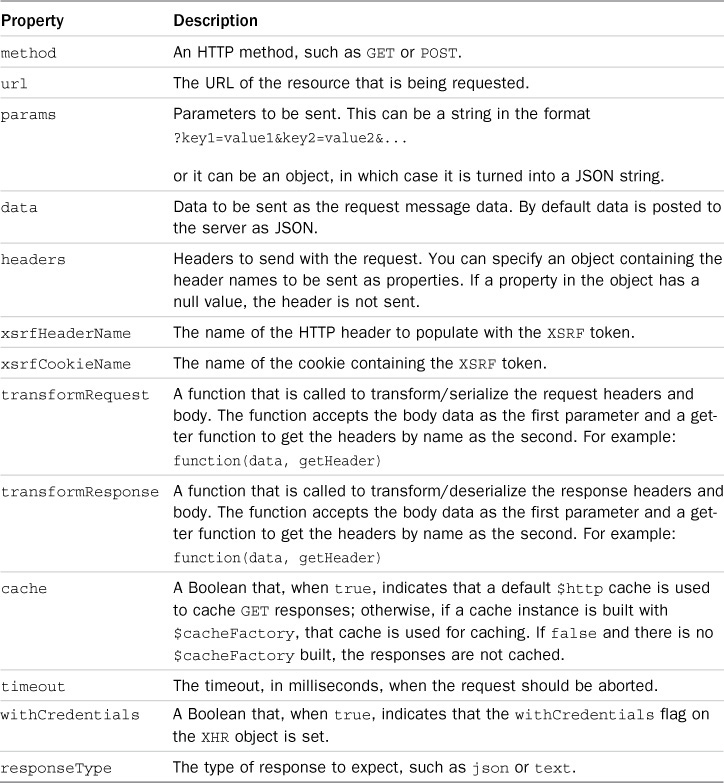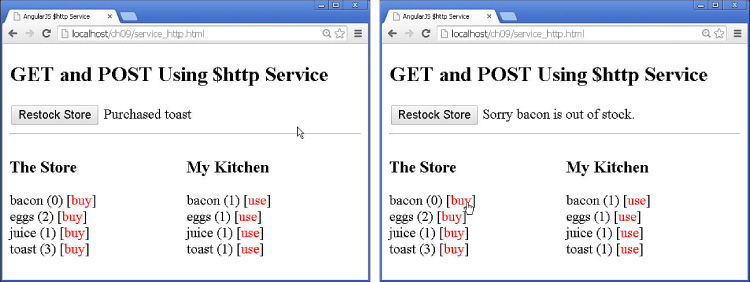Sending HTTP GET and PUT Requests with the $http Service
The $http service enables you to directly interact with the web server from your AngularJS code. The $http service uses the browser’s XMLHttpRequest object underneath, but from the context of the AngularJS framework.
There are two ways to use the $http service. The simplest is to use one of the following built-in shortcut methods that correspond to standard HTTP requests:
■ delete(url, [config])
■ get(url, [config])
■ head(url, [config])
■ jsonp(url, [config])
■ post(url, data, [config])
■ put(url, data, [config])
■ patch(url, data, [config])
Configuring the $http Request
In these methods, the url parameter is the URL of the web request. The optional config parameter is a JavaScript object that specifies the options to use when implementing the request. Table 9.2 lists the properties you can set in the config parameter.
You can also specify the request, URL, and data by sending the config parameter directly to the $http(config) method. For example, the following two lines are exactly the same:
$http.get('/myUrl'),
$http({method: 'GET', url:'/myUrl'});
Implementing the $http Response Callback Functions
When you call a request method by using the $http object, you get back an object with the promise methods success() and error(). You can pass to these methods a callback function that is called if the request is successful or if it fails. These methods accept the following parameters:
■ data: Response data.
■ status: Response status.
■ header: Response header.
■ config: Request configuration.
The following is a simple example of implementing the success() and error() methods on a get() request:
$http({method: 'GET', url: '/myUrl'}).
success(function(data, status, headers, config) {
// handle success
}).
error(function(data, status, headers, config) {
// handle failure
});
Implementing a Simple HTTP Server and Using the $http Service to Access It
The code in Listings 9.1 through 9.3 implements a simple Node.js web service and AngularJS application that accesses it. The web server contains a simple JavaScript object with items and count to mimic the stock of a store. The web application enables a user to tell the server to restock the store, and buy and use items. The example is very rudimentary so that the code is easy to follow, but it incorporates GET and POST requests as well as error-handling examples.
Listing 9.1 implements the Node.js web server that handles the GET route /reset/data and the POST route /buy/item. If the count of an item is zero, the /buy/item route returns an HTTP error. The first few lines simply set up the Node.js server. Don’t worry if you don’t follow exactly what is happening there. The initStore() function initializes the products and counts for items. On line 17 the GET route /reset/data is initialized and returns the store object as JSON. On line 21 the POST rout is initialized. This route decrements the item count and returns the store data (typically it would not need to return the full data, but for this simple example it makes the code cleaner). If the item is out of stock, a 400 error is returned.
You will need to stop the normal server.js HTTP server if it is running before starting service_server.js from Listing 9.1. Also, you will want to place the service_server.js file from Listing 9.1 in the parent folder to the service_http.html in Listing 9.2 for the paths to match up properly in the Node.js static routes. The structure should look similar to this:
./service_server.js
./ch09/service_http.html
./ch09/js/service_http.js
Listing 9.1 service_server.js: Implementing an Express Server That Supports GET and POST Routes for an AngularJS Controller
01 var express = require('express'),
02 var bodyParser = require('body-parser'),
03 var app = express();
04 app.use('/', express.static('./'));
05 app.use(bodyParser.urlencoded({ extended: true }));
06 app.use(bodyParser.json());
07 function initStore(){
08 var items = ['eggs', 'toast', 'bacon', 'juice'];
09 var storeObj = {};
10 for (var itemIDX in items){
11 storeObj[items[itemIDX]] =
12 Math.floor(Math.random() * 5 + 1);
13 }
14 return storeObj;
15 }
16 var storeItems = initStore();
17 app.get('/reset/data', function(req, res){
18 storeItems = initStore();
19 res.json(storeItems);
20 });
21 app.post('/buy/item', function(req, res){
22 if (storeItems[req.body.item] > 0){
23 storeItems[req.body.item] =
24 storeItems[req.body.item] - 1;
25 res.json(storeItems);
26 }else {
27 res.json(400, { msg: 'Sorry ' + req.body.item +
28 ' is out of stock.' });
29 }
30 });
31 app.listen(80);
Listing 9.2 implements the AngularJS application and controller. Notice that the buyItem() method calls the /buy/item POST route on the server and places the results in the scope variable $scope.storeItems. If an error occurs, the $scope.status variable is set to the msg value in the error response object. The resetStore() method calls the /reset/data GET route on the server and updates $scope.storeItems with the successful response.
Listing 9.3 implements an AngularJS template that includes the Restock Store button, status message on error, and a list of store items. Figure 9.1 shows how the item counts get adjusted when items are bought and used, and the out-of-stock error message is shown when the user tries to buy an out-of-stock item.
Listing 9.2 service_http.js: Implementing an AngularJS Controller That Interacts with the Web Server Using the $http Service
01 angular.module('myApp', []).
02 controller('myController', ['$scope', '$http',
03 function($scope, $http) {
04 $scope.storeItems = {};
05 $scope.kitchenItems = {};
06 $scope.status = "";
07 $scope.resetStore = function(){
08 $scope.status = "";
09 $http.get('/reset/data')
10 .success(function(data, status, headers, config) {
11 $scope.storeItems = data;
12 })
13 .error(function(data, status, headers, config) {
14 $scope.status = data;
15 });
16 };
17 $scope.buyItem = function(buyItem){
18 $http.post('/buy/item', {item:buyItem})
19 .success(function(data, status, headers, config) {
20 $scope.storeItems = data;
21 if($scope.kitchenItems.hasOwnProperty(buyItem)){
22 $scope.kitchenItems[buyItem] += 1;
23 } else {
24 $scope.kitchenItems[buyItem] = 1;
25 }
26 $scope.status = "Purchased " + buyItem;
27 })
28 .error(function(data, status, headers, config) {
29 $scope.status = data.msg;
30 });
31 };
32 $scope.useItem = function(useItem){
33 if($scope.kitchenItems[useItem] > 0){
34 $scope.kitchenItems[useItem] -= 1;
35 }
36 };
37 }]);
Listing 9.3 service_http.html: An AngularJS Template That Implements Directives That Are Linked to Web Server Data
01 <!doctype html>
02 <html ng-app="myApp">
03 <head>
04 <title>AngularJS $http Service</title>
05 <style>
06 span {
07 color:red; cursor: pointer; }
08 .myList {
09 display: inline-block; width: 200px;
10 vertical-align: top; }
11 </style>
12 </head>
13 <body>
14 <div ng-controller="myController">
15 <h2>GET and POST Using $http Service</h2>
16 <input type="button" ng-click="resetStore()"
17 value="Restock Store"/>
18 {{status}}
19 <hr>
20 <div class="myList">
21 <h3>The Store</h3>
22 <div ng-repeat="(item, count) in storeItems">
23 {{item}} ({{count}})
24 [<span ng-click="buyItem(item)">buy</span>]
25 </div>
26 </div>
27 <div class="myList">
28 <h3>My Kitchen</h3>
29 <div ng-repeat="(item, count) in kitchenItems">
30 {{item}} ({{count}})
31 [<span ng-click="useItem(item)">use</span>]
32 </div>
33 </div>
34 </div>
35 <script src="http://code.angularjs.org/1.3.0/angular.min.js"></script>
36 <script src="js/service_http.js"></script>
37 </body>
38 </html>
Figure 9.1 Implementing the $http service to allow AngularJS controllers to interact with the web server.


